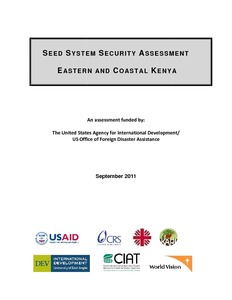Seed system security assessment: eastern and coastal Kenya
This report presents the results of a Seed System Security Assessment in Eastern and Coastal
Kenya, implemented September 2011, several weeks prior to the time of planting. The
assessment focused on result of Long Rains (LR) 2011, and immediate projections for Short
Rains (SR) 2011 planting. A seed system security assessment (SSSA) reviews the functioning of seed systems which farmers use, both formal and informal. It assesses
whether seed of adequate quality is available and whether farmers can access it. The approach also promotes strategic thinking about the relief, recovery or development vision ne
eded. For instance, during the stress period, should aid aim to restore the system as it
was, ex ante, or aim to strengthen it? ASSSA goes well beyond a conventional seed needs assessment as it hones in on specific seed security problems communities face, and then steers
response to actions which alleviate specific constraints, and often improve systems. (F
or full description of method, see http://www.ciat.cgiar.org/africa/pdf/sssa_manual_ciat.pdf
). Three sites were chosen for the assessment : in Kathonzweni, Tharaka North and Magarini.
The sites include zones where participating non-governmental organizations (NGOs) have
been prepared to address seed security-related constraints and opportunities. The three
selected sites also represent well the cross-section of the regions in which drought-stressed
agriculture and seed aid continue to unfold. Within Tharaka North, a fourth site, was also
assessed, tied specifically to Internally-Displaced Persons (IDPs) suffering from prolonged land
disputes. This report presents the seed security findings and recommendations across all four sites. Site-specific reports and recommendations tailored
for each site have been posted separately and can be obtained through Catholic Relief Services (Mwende.Kusewa@crs.org). Here, we focus on the across-site results as these may have
broader relevance to drought-prone areas in Eastern and Coastal Kenya where seed security responses are being planned in the short (1-2 seasons) and medium-term (3-5 seasons).

